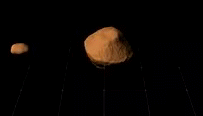Where small countries can make their mark in space development
Thursday, May 29, 2008
It seems to be the case that a country interested in getting itself involved in space first puts satellites into LEO, then works on sending a probe to the Moon, and then later on might go on to other projects (at the same time as pursuing a human flight program). Why not a mission to a near-Earth asteroid though? There are enough of these that pass by even closer to the Earth than the Moon, and it should be easy enough to create a probe on the cheap, then hiring Russia to send it up for them, and then being the only country in the world that has visited Asteroid X.
Some asteroids can be remarkably interesting, such as this one:
and:(66391) 1999 KW4 (also written (66391) 1999 KW4) is an Aten and Mercury-crosser asteroid discovered by LINEAR in 1999.
1999 KW4 has a moon orbiting it. The moon, designated S/2001 (66391) 1 or '1999 KW4 Beta' is ~360 m in diameter, and orbits 1999 KW4 'Alpha' in 0.758 d (16 hours) at a distance of 2.6 km.
The shapes of the two bodies and their dynamics are complex.[1] Among other bizarre properties, the equatorial regions of Alpha are very close to breakup: raising a particle a meter above the surface would put it into orbit around the object.This one's too close to the Sun to make it a possible destination, but there are enough relatively interesting asteroids that pass by the Earth that it should be easy enough to send a probe after one. I'm looking at you, Korea.
Some asteroids are easy enough destinations that NASA is even looking at a manned mission to one:
"But a very natural, early extension of the exploration capabilities of this new vehicle architecture would be a 'quick dash' near-Earth asteroid rendezvous mission," said Dan Durda, a senior research scientist in the Department of Space Studies at the Southwest Research Institute, Boulder, Colorado.
"That kind of early demonstration mission might last no more than 60 or 90 days," Durda said, "and take the crew no farther than a few lunar distances away from Earth."
Durda said he could imagine that such a flight might be made before the first lunar landing even--perhaps after a lunar orbital mission or two--in order to try out spacecraft systems on an even longer-duration flight.
Asteroids are often ignored in favour of large destinations like the Moon or Mars, but both of these require not just a landing but also taking off again in order to get back, which shoots up the cost quite dramatically. The good thing about asteroids is that they are so low in mass that the landing is more like a docking than anything, only involving a slow approach and then touchdown. The gravity is so low in fact that you would be thrown out into space if you were to jump from one.
Here's an example of what the size comparison might be for a ship landing on an average asteroid:

So what's the benefit of going to an asteroid? Well, among other uses it might be good to obtain a better understanding of something that could one day wipe out a ton of life on Earth.





0 comments:
Post a Comment